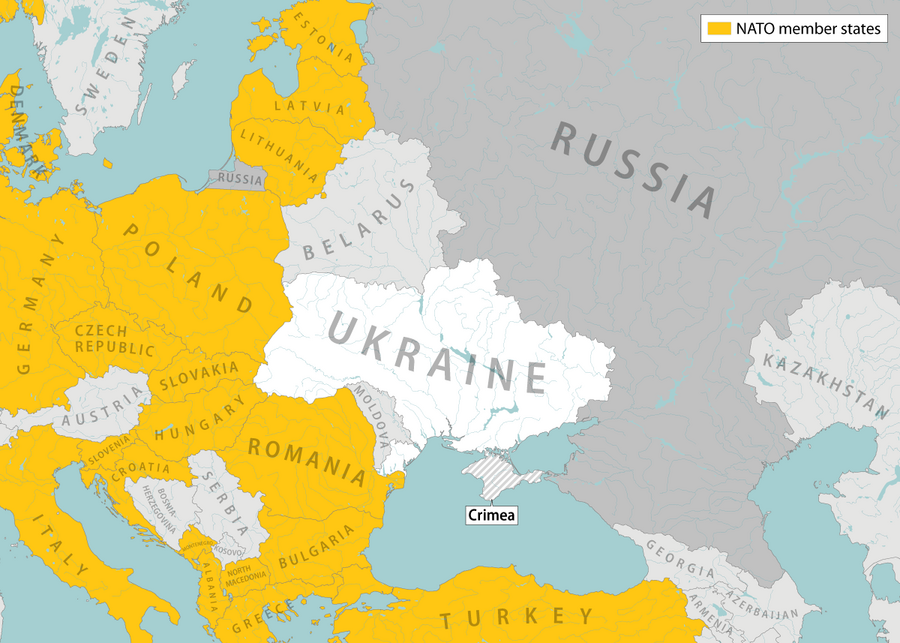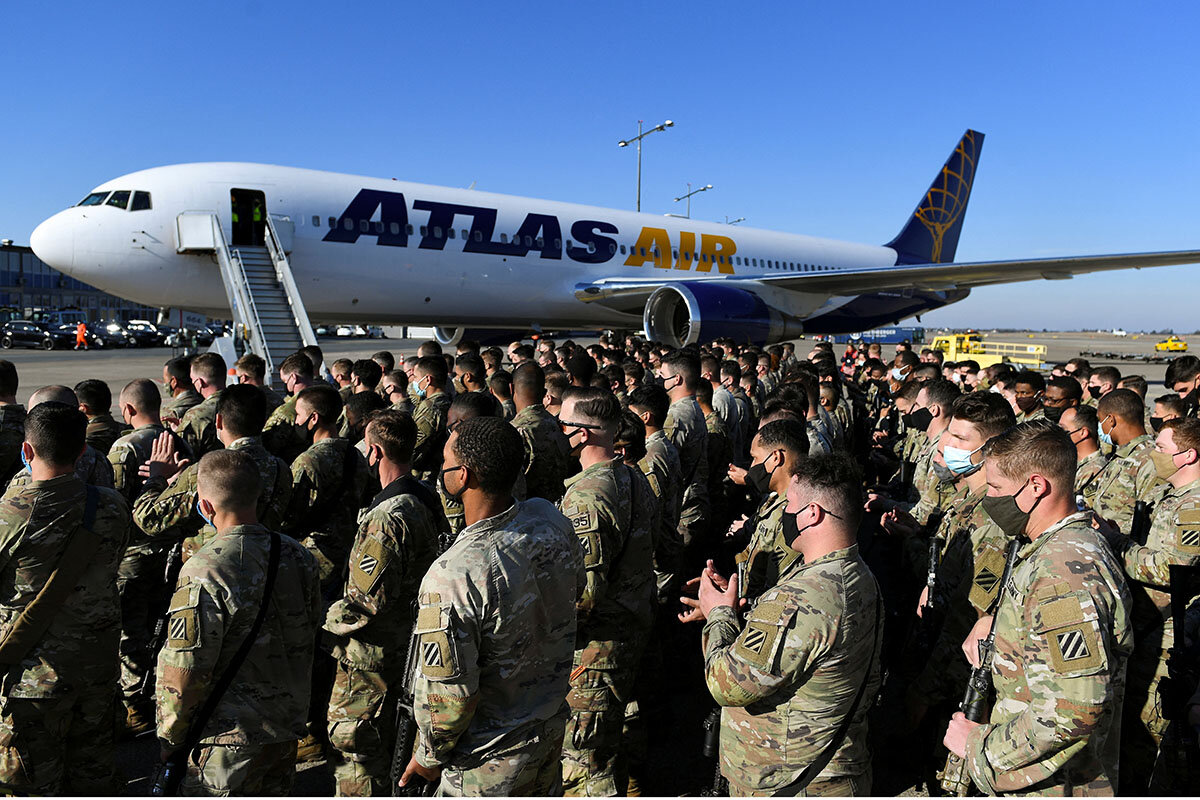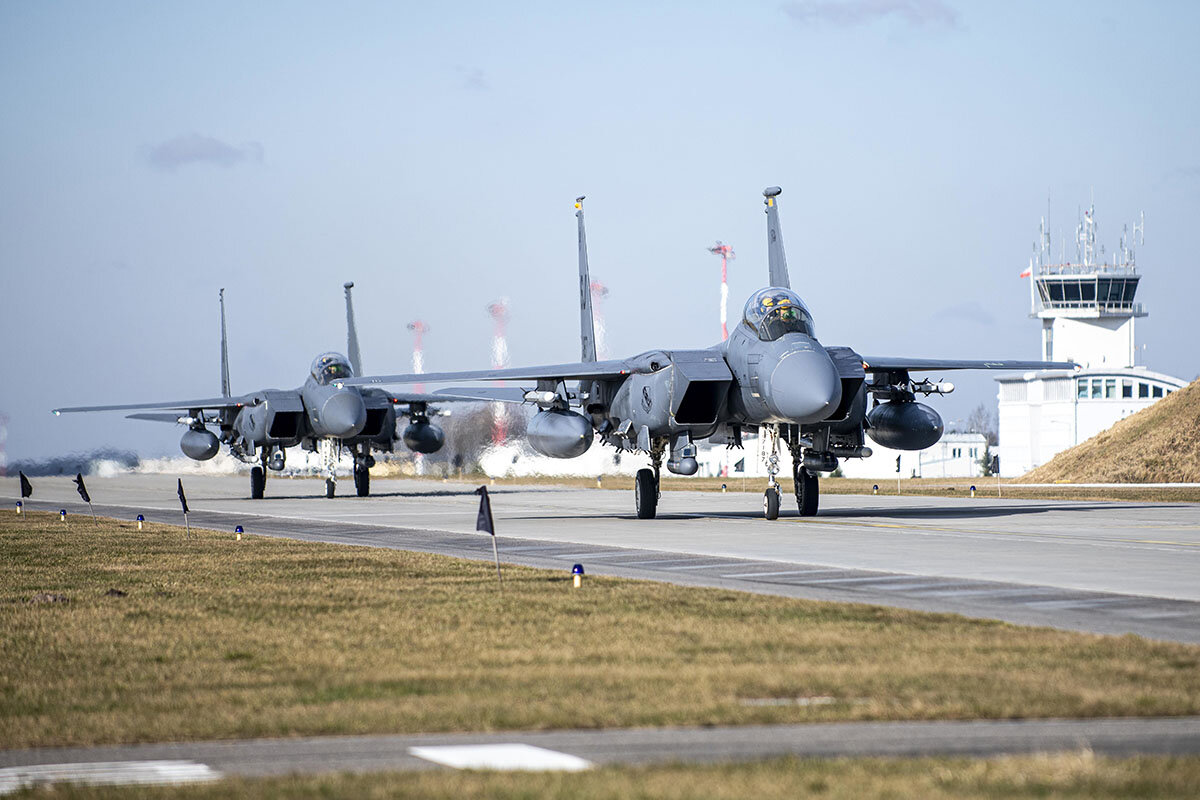NATO’s balancing act: Deter a militant Russia without provoking a fight
Loading...
| Brussels
As Russian forces invaded Ukraine last week to discourage the former Soviet republic – and any other countries that might be watching – from joining NATO, the Western alliance’s leaders redoubled their efforts to avert inadvertent hostilities that could lead to World War III.
Accomplishing this goal involves a tricky balancing act of showing the resolve to counter Russian President Vladimir Putin’s aggression while also trying to tamp down tensions following his veiled threats to use nuclear force against nations that “interfere” with his offensive.
Western leaders are endeavoring to do this through a combination of “tripwire” troops and clear messaging: Even as they announced a historic deployment of forces to Eastern Europe, NATO leaders assured Mr. Putin they will not venture onto Ukrainian soil.
Why We Wrote This
With Ukraine and Russia exchanging fire, it becomes more important than ever that NATO both signals the Kremlin that it is not an aggressor and deters further westward advance by Russian forces.
Alliance soldiers arriving at the easternmost border of NATO territory are being given access to deconfliction channels and technology designed to keep them from getting into accidental dust-ups. The goal is to avoid having to invoke Article 5, in which NATO allies are duty-bound to come to one another’s defense.
Preventing “spillover”
Avoiding accidental NATO-Russia run-ins starts with underscoring allied red lines, so that Mr. Putin doesn’t get any ideas about venturing farther west than Ukraine.
To put an exclamation mark on their vow that the alliance will defend “every inch” of its territory, roughly 14,000 U.S. troops are deploying to Eastern Europe on what’s known in Pentagon parlance as an “assure and deter” mission. Some will serve in the NATO Response Force, which is being mobilized for the first time in alliance history.
They will be led by a NATO group called the Very High Readiness Joint Task Force. The troops will be bolstered by a host of high-tech weapons, including half a dozen U.S. F-35 stealth fighter jets bound for Estonia, Lithuania, and Romania, which will host two each.
The goal of these forces is not to engage with Russian troops – as defense officials have repeatedly emphasized – but to prevent “spillover fighting” and “any misunderstanding that we are not ready to protect and defend all allies,” as NATO Secretary-General Jens Stoltenberg put it last week.
At the same time, NATO commanders have reached out to Russian forces to “do everything we can to ensure deconfliction,” Mr. Stoltenberg said.
One particular risk of miscommunication lies on the Black Sea, where NATO and Russian naval forces are operating.
There, the small, nearly uninhabited Snake Island, home to a Ukrainian military base recently attacked by Russian ships, offers a case study in complexity, says Iulia-Sabina Joja, director of the Frontier Europe Initiative at the Middle East Institute.
The island was the subject of a border dispute between Ukraine and Romania. International courts ruled in Ukraine’s favor, but much of the maritime area around the island remains the territory of Romania, a NATO member. The issue illustrates “how risky and close these possible confrontations could be,” says Ms. Joja, who formerly served at NATO and as an adviser to the Romanian president.
It doesn’t help that Russia has engaged in GPS “spoofing” in the Black Sea, subtly changing ships’ navigation coordinates. Russia can also jam GPS receivers. To counter these contingencies, U.S. Space Command said last week that its units are working with U.S. European Command in the region on technological backstops.
Showing restraint
In all of this, the telegraphing of the Western alliance’s intent is critical to avoid any misinterpretation of its troop movements by Mr. Putin – and by the troops themselves.
An illustration of just how the Pentagon is doing this came at a press briefing hours after the invasion began, when a dogged reporter asked repeatedly if troops in Poland could potentially be drawn into fighting in Ukraine. “They’re not going to be accidentally drawn into Ukraine,” Pentagon press secretary John Kirby said, with emphasis as much for international as for domestic consumption.
It is a point Pentagon officials have stressed nonstop, and a clear indication of command to the ranks. It also reinforces expectations NATO leaders have for its troops on the border. This is particularly important given that many of them are young and from countries where historic enmity toward Russia could encourage rash behavior that runs the risk of escalation.
On this front, so far, so good, says Elisabeth Braw, senior fellow at the American Enterprise Institute (AEI) and a former senior fellow at the Royal United Service Institute for Defense and Security Studies in London. Polish troops have been barraged with disarmed rockets, blinded with lasers, and even pelted with rocks by soldiers across the border in Belarus, a Russian ally.
“How can you accurately assess whether what’s coming your way is live fire or empty shot when you’re a young Polish soldier?” she adds. “But they’ve shown incredible restraint, and clearly that’s their intent.”
A boost to defense spending
Beyond military miscalculations leading to accidental war, the miscommunication challenge in the months and years to come will involve identifying how NATO failed to discourage Mr. Putin from invading Ukraine in the first place – and how now to prevent tragic loss of life.
Some advocate for a return to old defense postures as the new way ahead. “I was wrong in my forecast that Putin would not launch an invasion,” says AEI’s Frederick Kagan, an architect of the surge in Iraq and long a barometer for hawkish thinking.
Since the end of the Cold War, NATO’s boundary “has been like a solid wall that no one will cross because the consequences of doing that are so clear.” Mr. Putin’s actions in Ukraine “should eliminate any thought in our minds about what we think Putin will and won’t do.” They should also dramatically boost military budgets for the democratically minded, he adds.
And that’s precisely what’s happening now. “In a very dramatic and tragic way this [war in Ukraine] has changed the equation” in Europe. “Those who were sitting on the sidelines, or who had adopted a wait-and-see approach” toward Moscow, are now increasing defense spending and mobilizing troops, notes Ian Lesser, vice president of the German Marshall Fund of the United States.
Indeed, the NATO allies may yet impose penalties on Mr. Putin that ultimately prove he’s the one who has miscalculated, he says. “The net result of all this will be a lot more NATO capability facing Russia in the years ahead,” Dr. Lesser adds. “I’m not sure that’s what Putin anticipated.”









